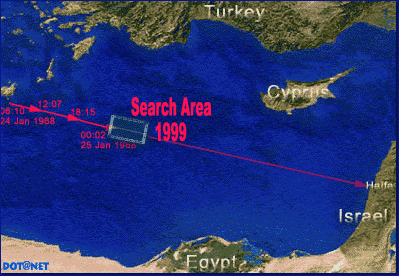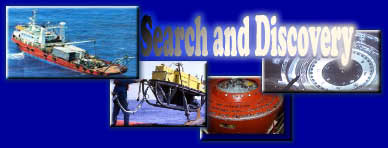
|
For 31 years Israel never ceased her effort to find her lost sons.
One of Israel's strongest traditions is to
bring home all killed and missing soldiers. In Israel's 52 years of
existence she paid dearly for getting the remains of her MIA warriors.
Jews will do their outmost in order to give a proper Jewish burial
to every Jewish deceased. For 31 years all effort were in vain. 25 missions that searched almost every part of the eastern Mediterranean were fruitless. As weird as it sounds, the only area that was not checked was along Dakar's route to Haifa. Along a virtual course between her last known position point and Haifa. Why did it take 31 years to find Dakar where she logically should have been. The answer has 2 parts. One is the emergency buoy marker that was washed to the coast of Khan Yunis a year after Dakar's disappearance and the other part of the answer is the advanced techniques for deep sea exploration that were developed along the last 3 decades and became handy just lately. |
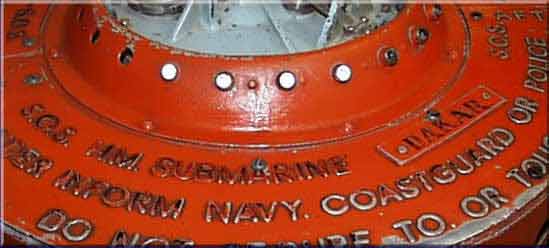 |
|
|
S.O.S
H.M. SUBMARINE DAKAR SOS |
|
On
February 9th 1969, a
year after Dakar's disappearance,
an Arab fisherman found Dakar's stern emergency buoy marker on the coast
of Khan Yunis, an Arab village south/west of Gaza. The Dakar had 2 such
buoy markers. One in the bow and one in the stern. They were secured
behind wooden doors in cages under the deck and attached to the submarine
with metal cables 200 meters (600ft) long. Those doors could be opened
from the inside of the submarine. When a submarine is unable to surface,
the crew can open the doors and the buoy will surface and transmit for
the next 48 hours an SOS message. The
location of the sunken submarine can then be determined by radio direction
finders. Part of
the cable (65 cm) that attached the buoy to the Dakar was found. Scientists
and experts examined the buoy number of times and determined that the
buoy was attached to the Dakar for a year until the cable broke
completely. It was determined that the Dakar rests in depth between
150 to 326 meters, and that she is 50-70 nautical miles away from her
planned route.
|
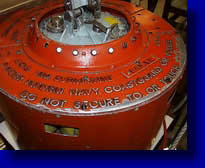 |
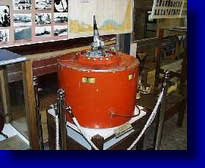 |
|
Dakar's
stern buoy emergency marker on display at the naval museum at Haifa
|
|
|
Today,
after the rediscovery of Dakar it is clear that the conclusions of sea
experts and marine scientists were false and misled the search operations
for 31 years. Dakar never diverted from her planned route and her wreck
rests in a depth of almost 3 kilometers. The emergency buoy marker was
not attached to the submarine during the first year. It must have been
cut close to the accident time. It is not out of question that the radio
station in Nicosia really did receive the emergency call radioed by
the emergency buoy. It then took most of the passing year for the buoy
to drift southeasterly direction toward the eastern shores of the Mediterranean.
|
A New Approach
|
After
25 barren search missions, the CIC of the Navy, Admiral Alex Tal dismissed
the previous search committee and nominated Rear Admiral(ret.) Gideon
Raz as head of the new committee. All previous search missions concentrated
in relatively shallow waters according to the buoy research conclusions.
This time, Raz and his committee members consulted with US Navy experts
and scientists of deep water research. Based on new deep water technology,
satellite advanced technology and calcified information obtained from
the US Navy about the Mediterranean currents, led to a new conclusion.
|
The 26th Search Expedition is on
|
On
9 May 1999 the two charted sea vessels arrived at the search area. The
designated search frames box area was approximately 60 nautical miles
long, nearly 8 nautical miles wide and contained 16 search lanes. With
a speed of 2 knots per hour it takes between 30 to 40 hours to monitor
the sea bed of each search lane.
Searching was conducted using the AMS-60, a wide-swath sonar and the REMORA 6000, a remotely operated vehicle (ROV) equipped with both video and still cameras. |
 |
|
|
The
2 Cypriots ships that were chartered by the American firm Nauticos.
Flying Enterprise on the left towed the advanced sonar AMS-60 behind.
Argonaut on the right carried the ROV, a robot with video camera.
|
|
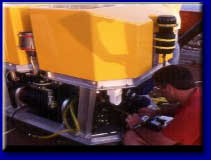 |
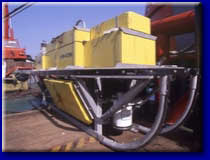 |
|
REMORA
6000, a remotely operated vehicle (ROV) equipped with both
video and still cameras, was used to verify the sonar contacts and identify
the DAKAR
|
AMS-60
sonar search system used to locate the Dakar. Nauticos and Williamson
personnel operated this system twenty-four hours per day during at-sea
operations.
|
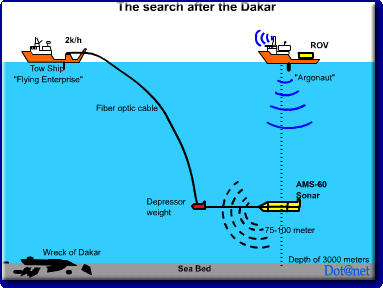
Dakar is found
|
At
the evening of the 24th May the sonar detected the presence of a large
body resting on the seabed. The team was able to view on the monitor
a large black spot and a scattering of smaller dots around it. Dettweiler
ordered
to winch down the ROV, a remotely operated vehicle equipped with both
video and still cameras, in order to conduct a more specific visual
survey and make a positive identification. Bad weather delayed the investigation
for another 3 days. At 0700, on May 28th the ROV dove and 4 hours later
it started to transmit pictures to the ship 2900 meters above. There
was no place for doubt. It was clear that those are the remains of a
submarine. The
submarine rests on her keel, her bow points to the northwest, the hull
is broken in two between the engine room and the stern. The conning
tower is ripped off and on its side, as the forward part of the tower(the
bridge)lies 230 meters away. The stern of the submarine, with its propellers
and dive planes, broke off the submarine and rests not far from the
main hull.
|
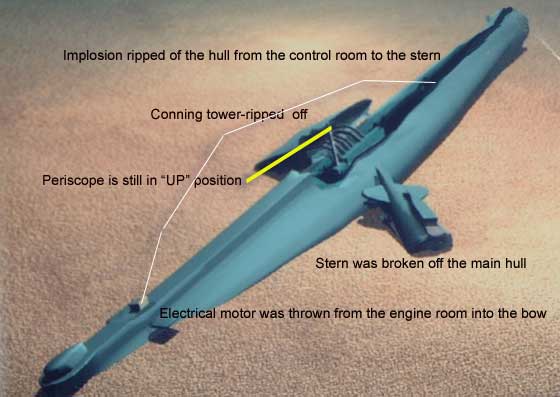
Illustartion
of the Dakar as she rests at the bottom of the sea
|
Navy headquarters in Tel-Aviv was informed of the finding on Friday May 28th. As the bottom of the Mediterranean is a graveyard for many German, Italian and British WWII submarines, a team of three former commanders of submarine squadron were rushed to the search area on the deck of a fast missile boat. Rear Admiral Raz, Commander Amir and Commander Keisari carefully examined the video film, searching for details characteristic of the Israeli "T" class boats. A few hours later they gave the final confirmation that the lost submarine, INS Dakar had finally been found. It was Friday, Sabbath's eve, and at 8:00 PM, all news broadcasting started with the words that sent a shiver through the nation: INS Dakar was found 500 kilometers (310 miles or 270 sea miles) away from the shores of Israel, on the bed of the Mediterranean, in 2,900 meters of waters (9,514 feet), the Dakar rests. |
|
Pictures from the depths and the past
|
What
happened to Dakar?
|
For more information please visit the following pages:
 |
||
 |
 |
Sponsored
by :
Zahal, IDF, Israel military store
